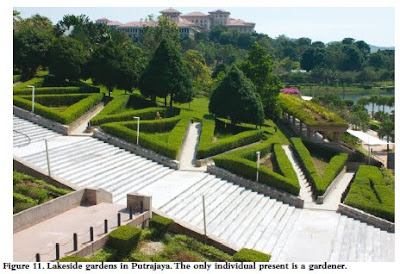I have been doing some reading/research on Putrajaya (the planned capital in Malaysia [c 1999]), and planned capitals more generally. I wanted to share some significant conceptions with you, and some of my thoughts on how they may influence this project.
Planned capitals are a medium for the political elite to express their conceptions of statehood. From Versailles to Washington to Putrajaya, the cities put on display the values of their designers, geographically and architecturally. Planned capitals tend to include ostentatious layouts and buildings
I see this as a major issue with planned capitals. Generally planned by the elite; ostentatious and unwelcoming in their physical form - they are artificial and unorganic. They have come to epitomise the undemocractic, the master-planned imposition - rather than the will of the people they supposedly represent.
Q. How can we make the planned capital more democratic?
Peter Hall points out that planned capitals tend to remain specialized political cities, rarely surpassing the old commercial centers in economic power.5 Planned capitals like Washington, Canberra, and Brasília have developed into major cities, but even after decades or even centuries, they remain somewhat inferior to their countries’ respective economic power centers.
They generally lack any form of urban life beyond their political function, and they lack relevance, meaning, or psychological attachment to the people of their nation.
Really what constitutes a city? To me it would be life/activity, cosmopolitanism, attachment meaning and relevance, a sense of place. If these are the criteria with which to judge Putrajaya and Canberra - I would find it hard to define them as real cities. Rather, when one visits them they almost have the character of towns. I suspect Brasilia is the same (despite its modernist roots). See lack of activity, public space is purely aesthetic in Putrajaya in photos below.
Q. How can we make the planned capital a true city - a place of habitat, opportunity and atmosphere?
Putrajaya seems to have attempted to counter the problems described above. It is placed only 25km from Kuala Lumpur and near to KL International Airport (KLIA). In this sense, the government has tried to build up the economic base of the city, make it internationally and domestically connected etc. - ie. more relevant and capture a multitude of activities (beyond the political).
Some of you may have heard of the concept of the "multimedia super corridor" in Malaysia. The Government there has an obsession with modernisation (link to national identity), and sought to create a corridor of smart industries (eg. technology, communications) from KL to KLIA. This would lead the social and economic development of the nation it was theorised. See communications network map for the nation below. Putrajaya was meant to sit at the centre of this national network, at the centre of national economic and social development - the new Malaysia.
Q. Could a new capital in Australia stimulate a better economic and social future for the country (ie. not just have a political function). How would it do this? Is this realistic?
Some more plans of Putrajaya:








Thanks for the questions MattL, it reminds me the famous saying, "cities are made out of many different layers" it refers to the layer of history, social cultural and economical evolvement and etc. Most of the planned capital cities are lack of those different layers as they are new creations. i guess one of the challenges for us is to create a new set of rules that will allow the capital city to sustain itself over time.
ReplyDeleteAfter reading your insightful comments Matt I can say that examples like Putrajaya show the eternal risk of single sweep political creations be it capitals, infrastructure, education, etc. that without a more delicate, profound understanding and sustained effort they can quickly become sterile, near dead on arrival.
ReplyDeleteJP
I believe this ties in nicely with the conversation we where having during our dinner on Friday 02/09 about the fact that we should first and foremost aim at creating a good city, a city that is relevant to its citizens, to the nation and the world and only secondly a statement in grandiosity. What do you feel/think about that?
Also, following on from these thoughts it nearly feels like we could do a new capital that is basically an infill capital that can occur close or at the heart, maybe in a brownfield site, of an existing city... But the problem with that is that when you have two cities that are near equals in a nation, like Melbourne and Sydney are in Australia, it is always contentious who gets the capital status.